Japanese tanks of World War II
The Imperial Japanese Army (IJA) initially purchased foreign tanks for evaluation during World War I, and began developing its own indigenous designs during the late 1920s.
Due to the war with China, Japan produced a large number of tanks. Although initially the Japanese used tanks to good effect in their campaigns, full-scale armored warfare did not occur in the Pacific and Southeast Asian theaters as it did in Europe, and tank development was neglected in favor of naval activities. The best Japanese designs were never used in combat as they were kept back in expectation of defending the Japanese Home Islands.
Initial tank procurement
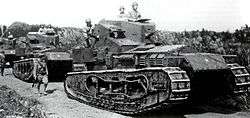
Near the end of World War I, the Japanese showed an interest in armored warfare and tanks and obtained a variety of models from foreign sources. These models included one British Heavy Mk IV and six Medium Mark A Whippets, along with thirteen French Renault FTs (later designated Ko-Gata Sensha or "Type A Tank"). The Mk IV was purchased in October 1918 while the Whippets and Renaults were acquired in 1919.[1]
Trials with these vehicles were successful, and the Army decided to establish an armored force in 1925, planning to form three light tank battalions and one heavy tank battalion. However, the greatest problem was equipping these units, as the Japanese did not have any indigenous tank production capability. The IJA therefore sent a mission to purchase more tanks from Britain and France, requesting newer designs. However, the newer tanks were not available as these countries had difficulties supplying them to their own armored forces, and the only available model was the older Renault FT.[2] The Japanese reluctantly imported these but in 1929 they were able to acquire ten examples of its successor, the Renault NC1 (designated Otsu-Gata Sensha or "Type B Tank"). Both types of tanks were still in active service in 1940, and additional vehicles and spare parts were obtained after the Japanese occupation of French Indochina. The Japanese also purchased several Vickers 6-Ton tanks and Carden Loyd tankettes and used these as a basis for further development in tanks.[3]
Doctrine
As with the Americans and the Italians, the Japanese originally adopted French-designed tanks, and were influenced by their doctrines and employment. As with many other nations at the time, the Japanese viewed the tank as a tool largely used in direct support of their infantry, and were rarely allowed independent action. During the Second Sino-Japanese War, Japanese tanks were successful, especially as the Chinese had no significant armoured forces of their own.
With their defeat by the Soviet Union at Nomonhan in 1939, the Japanese began to rethink their tank designs and doctrine, although their emphasis would continue to remain on supporting the infantry. However, with the beginning of the Pacific War, Japan's priorities shifted to warship and aircraft production, and resources for the production of armored vehicles for the Army were diverted or curtailed.[4]
In addition, the terrain of Southeast Asia and the islands of the Pacific were in general not suited to armored warfare, being largely tropical rainforests. Aside from the invasion of Malaya, and the Philippines, large-scale Japanese use of tanks was limited and therefore development of newer designs were not given high priority.
Older tanks continued to be used as defensive emplacements and infantry support weapons. Advanced Japanese tank designs which could challenge Allied tanks did not appear until the close of World War II; as with many innovative weapons projects launched by Japan in the final years of the war, production could not advance beyond either small numbers or the prototype stage due to material shortages, and the loss of Japan's industrial infrastructure to the Allied bombing of Japan.[5][6]
Japanese designs
For both security and logistical reasons, many engineers in the Japanese Army Technical Bureau during the early 1920s were adamant that future tanks should be made in Japan. General Suzuki (chief of the Technical Bureau) protested the Ministry of War decision to purchase foreign designs, which ultimately led to that decision being reversed.
However, indigenous design and production of armored vehicles would prove to be difficult, due to minimal experience with military motor vehicle design (the engineers had only designed several types of trucks and one type of tractor), along with low priority for tank steel production. Moreover, the first design had to be completed in only two years or the program would be canceled.
Type 87 Chi-I medium tank (Experimental 1st tank)
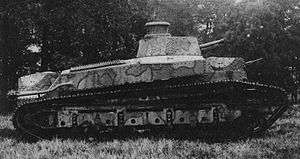
Development of the first Japanese-designed tank began in June 1925. A team of engineers of the Technical Bureau participated in the development, including a young army officer, Major Tomio Hara.[7] Hara later became the head of the tank development department and rose to the rank of General. According to Hara, the first tank on the agenda was to develop a medium main battle tank.[8] The team started their design and worked hard to complete the project within the two years allocated.[9] As this was the first tank designed in Japan, they had to begin with almost every component built from scratch.[10]
The design was completed in May 1926 and production was ordered to begin at the Osaka Army Arsenal. At the time, there was little heavy industry allocated to the production of motor vehicles in Japan, so there were significant difficulties creating the prototype. The prototype Type 87 Chi-I was completed by February 1927. The 20-ton tank underwent field trials, but proved to be under-powered.[11] The weight of the initial prototype and its low speed did not impress the Imperial Japanese Army General Staff Office, so a new requirement was issued for a lighter tank, with a nominal 10-short-ton (9.1-metric-ton) weight. The new design was modeled after the Vickers Medium C which had been bought by the Japanese Army in March 1927.[12] Along with the Osaka Army Arsenal, Sagami Army Arsenal was also assigned to oversee the design and manufacture of assorted types of armored vehicles and tanks.
The Type 87 Chi-I had a complex parallelogram suspension system with two pairs of road bogie wheels per leaf spring arrangement.[13] Hara designed a bell crank scissors suspension that paired the bogie wheels and connected them to a coil spring mounted horizontally outside the hull. This suspension became standard on the majority of the subsequently designed Japanese tanks and can be seen on the Type 95 Ha-Go light tank and Type 97 Chi-Ha medium tank, as examples.[14]
Type 89 Chi-Ro medium tank

The IJA decided that the Type 87 Chi-I was too heavy and slow to be used as its main tank, so the Type 89 Chi-Ro was developed to overcome these shortcomings.[15] The new design weighed 12.8 tons and used stronger and lighter steel plate instead of the Type 87's iron armor. Armament was a Type 90 57 mm gun, along with two Type 91 6.5mm machine guns.[16] The Type 89 design was completed in 1929, with production starting in 1931, making this the first tank to be mass-produced in Japan.[17] The Type 89 had two variants - the Kō ("A"), which used a water-cooled gasoline engine, and the Otsu ("B"), with an air-cooled diesel engine and improved frontal armor.[17] Of the two versions made, a total of 113 Kō tanks and 291 Otsu tanks were produced.[18] The Type 89 first saw combat in China, but was in the process of being replaced by the Type 97 Chi-Ha by the start of World War II. The designation is also known as the Type 89 "I-Go" and sometimes transliterated "Yi-Go".[19][20]
Type 95 Ha-Go light tank
.jpg)
The Type 95 Ha-Go was a replacement for the Type 89 medium tank which was considered too slow for mechanized warfare. The prototypes were built by Mitsubishi and production was started in 1936, with 2,300 completed by the end of the war.[21] It was armed with a 37 mm main gun and two 7.7 mm (0.303 inch) machine guns, one in the rear section of the turret and the other hull-mounted. The Type 95 weighed 7.4 tons and had three crewmen.[22][23] It served during the Battle of Khalkhin Gol (Nomonhan) against the Soviet Union in 1939,[24] against the British Army in Burma and India,[25] and throughout the Pacific Theater during World War II. On 22 December 1941 the Type 95 light tank earned the distinction of being the first tank to engage in tank vs tank combat with US manned American tanks (M3 Stuart light tanks in the Philippines) during World War II; and the only enemy tanks to have ever landed on North American soil during any war.[25][26] Several variants were built, among them: the prototype Type 3 Ke-Ri, which mounted a 57 mm Model 97 gun; the Type 4 Ke-Nu; and the Type 5 Ho-Ru, a prototype casemate-hulled turretless self-propelled gun similar to the German Hetzer, but with a Type 1 47 mm tank gun.[27]
Type 97 Chi-Ha medium tank
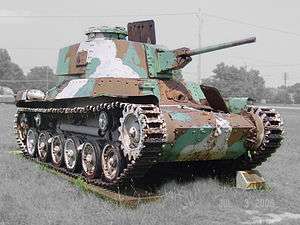
The Type 97 medium tank Chi-Ha (九七式中戦車 チハ Kyunana-shiki chu-sensha chiha) was the most widely produced Japanese medium tank of World War II, with about 25 mm thick armor on its turret sides, and 30 mm on its gun shield, considered average protection in the 1930s.[28][29] Some 3,000 units were produced by Mitsubishi, including several types of specialized tanks. Initial versions were armed with a low-velocity Type 97 57 mm tank gun, but from 1942 onwards, the Model 97 was armed with a high-velocity Type 1 47 mm tank gun, mounted in a larger three man turret.[30] This version was designated Shinhoto Chi-Ha ("new turret")[31] and is considered by many to be one of the best Japanese tank designs of the war.
Type 98 Ke-Ni light tank

The Type 98 light tank Ke-Ni (九八式軽戦車ケニ Kyuhachi-shiki keisensha Ke-Ni) was designed to replace the Imperial Japanese Army's Type 95 Ha-Go light tank. It is also referred to as the Type 98 Chi-Ni light tank by some sources.[32] Although developed in 1938 to address deficiencies in the Type 95 design already apparent from combat experience in Manchukuo and China in the Second Sino-Japanese War. The prototype of the new Type 98 tank was completed in 1939 but production did not begin until 1942. With the start of World War II, the Imperial Japanese Army General Staff quickly realized that the Type 95 design was vulnerable to heavy machinegun fire - 0.5 in (13 mm) - and as such attempted to develop a light tank with the same weight as the Type 95, but with thicker armor.[33] The Type 98 had a two-man turret, an improvement on the asymmetrical turret used on the Type 95, carrying a Type 100 37mm tank gun, with a muzzle velocity of 760 m/s (2,500 ft/s) and with a coaxial 7.7 mm machine-gun to the side. A total of 104 Type 98s are known to have been built: 1 in 1941, 24 in 1942 and 79 in 1943.[34] One prototype variant built was the Type 98 Ta-Se, an anti-aircraft tank which mounted a 20 mm AA gun.[35] Another variant was known as the Type 2 Ke-To light tank, which began production in 1944. It mounted an improved Type 1 37mm gun in an enlarged turret.[33] However, only 34 tanks were completed by the end of the war.[36]
Type 1 Chi-He medium tank
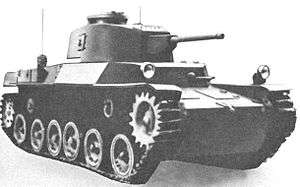
The Type 1 Chi-He was developed in 1942 to replace the Type 97. The newer tank proved to be superior to the Type 97 in design, speed and armor protection.[37][38] The three-man turret and 47 mm gun of the Type 1 were retrofitted on the hull of the Type 97 which the factories were already producing. Even so, production did not begin until 1943, due to the higher priority of steel allocated to the Imperial Navy for warship construction. After less than one year, production was discontinued in favor of the Type 3 Chi-Nu medium tank.[39] The Type 1 Ch-He tanks were allocated to the defense of the Japanese home islands.[40]
Type 3 Chi-Nu medium tank
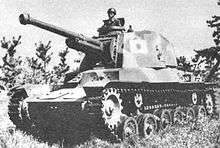
The Type 3 Chi-Nu medium tank was urgently developed to counter the American M4 Sherman medium tank. Originally, the next tank in development to replace the Chi-He was the Type 4 Chi-To medium tank. However, the development of the Type 4 Chi-To was delayed, and a "stopgap tank" was needed.[41] The development of Chi-Nu started in May 1943 and was finished by October. The low priority given tanks, along with the raw material shortages meant that the Type 3 did not enter production until 1944.[42] It was the last design based directly on Type 97 lineage.[43] The Chi-Nu retained the same chassis and suspension of the Type 1 Chi-He but with a new large hexagonal gun turret and a commander's cupola.[44] The main armament, a Type 3 75 mm tank gun, was one of the largest guns used on Japanese tanks.[45] The Chi-Nu was the last IJA tank deployed, and production continued until the end of the war. The tanks produced were allocated to the Japanese home islands to defend against the projected Allied Invasion.[39]
Type 4 Chi-To medium tank
The Type 4 medium tank Chi-To (四式中戦車 チト Yonshiki chūsensha Chi-To) was one of several new medium and heavy tanks developed by the Imperial Japanese Army towards the end of World War II. It was by far the most advanced Japanese wartime tank to reach the production phase.[46]
The Type 4 Chi-To was a thirty-ton, all-welded tank with a maximum armor thickness of about 75 mm. It was much larger than the Type 97 Chi-Ha, with a longer, wider, tall chassis, supported by seven road wheels.[6][47] The main armament, a Type 5 75 mm tank gun was housed in a large powered, well-armoured hexagonal gun turret along with a coaxial machine gun. A single Type 97 heavy tank machine gun was mounted in the front hull. Only two Type 4 Chi-To tanks were completed prior to the end of the war with an additional four chassis being manufactured. Neither of the two completed units saw combat use.[46][48]
Type 5 Chi-Ri medium tank
The Type 5 medium tank Chi-Ri (五式中戦車 Go-shiki chusensha Chi-ri) was the ultimate medium tank developed by the Imperial Japanese Army in World War II. Intended to be a heavier, lengthened, more powerful version of Japan's sophisticated Type 4 Chi-To medium tank, in performance it was designed to surpass the US M4 Sherman medium tanks being fielded by the Allied forces. Originally, the tank was to be fitted with the same Type 5 75 mm tank gun used on the Type 4 Chi-To.[49][50] Eventually, an 88 mm gun (based on the Type 99 88 mm AA Gun) was planned for the turret; a secondary weapon of a front hull-mounted Type 1 37 mm tank gun was fitted in the position normally taken by a machine gun.[6][49]
As with many innovative weapons projects launched by Japan in the final days of World War II, production could not advance due to material shortages, and the loss of Japan's industrial infrastructure to the allied bombing of Japan.[5] The single incomplete Type 5 prototype was seized by American forces during the occupation of Japan.[6][51]
Experimental Type 5 Ho-Ri tank destroyer

The Ho-Ri was a more powerful tank destroyer (gun tank) using a 105 mm cannon in place of the 75 mm design and an additional 37 mm gun. It was to use the Type 5 Chi-Ri tank chassis. The superstructure for the main gun was placed at the rear and the engine was to be placed in the center area of the chassis.[52] Another version was to have a twin 25 mm anti-aircraft gun on top of the rear superstructure.[53] No prototypes were built.[54]
O-I superheavy tank
The O-I experimental superheavy tank had three turrets and weighed 120 tons, and required a crew of 11 men. It was 10 meters long by 4.2 meters wide with an overall height of 4 meters. The armor was 200 mm at its maximum, and the tank had a top speed of 25 km/h. It had two gasoline engines, and was armed with 1 x 105 mm cannon, 1 x Type 1 47 mm gun (in a forward-mounted sub-turret), and 3 x Type 97 7.7 mm machine guns (one mounted in a forward sub-turret).[55] It has been reported the one prototype of the O-I was manufactured in 1943. However, the tank was "unpractical" and the project ended. No images of the O-I are known to exist.[55]
Amphibious tanks
.jpg)
During the 1930s and 1940s, Japan produced several amphibious tank designs,[56] including the SR-II Ro-Go, Type 1 Mi-Sha, Type 2 Ka-Mi, Type 3 Ka-Chi, Type 5 To-Ku; amphibious transports included the F B Swamp Vehicle, Type 4 Ka-Tsu APC, and Toku 4 Shiki Naikatei APC. All were for use by the Japanese Special Naval Landing Forces. The Type 1 was an early experimental design, that led to the Type 2 Ka-Mi, which was the first production Japanese amphibious tank; although beginning in 1942 only 182 to 184 units were built.[34][57] The Type 3 Ka-Chi was based on an extensively modified Type 1 Chi-He tank and was a larger and more capable version of the earlier Type 2 Ka-Mi amphibious tank.[58] Only 19 Type 3 Ka-Chi tanks were built during the war.[59] The tanks were used later in the war as dug-in pillboxes on Pacific islands.
Overall production
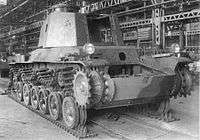
In the period between 1931 and 1938 the Japanese built nearly 1,700 new tanks[18] By 1939, Japan produced 2,020 operational tanks.[60] In the following year, Japan had the 5th largest tank force in the world.[61] The peak of Japanese tank production was in 1942, but declined afterwards owing to aircraft and warship priorities, along with material shortages. By 1944, total production of tanks and AFV's had fallen to 925 and for 1945, only 256 were produced.[34] Japan developed many experimental and operative armored vehicles, tanks and tank-destroyer types throughout the war; but largely held them in reserve, for home-land defense.[62]
See also
- List of Japanese armoured fighting vehicles of World War II
- Tanks in the Japanese Army
- List of Japanese armored divisions
References
Notes
- ↑ Zaloga 2007, p. 4.
- ↑ Hara 1972, p. 3.
- ↑ Foss. Tanks: The 500. p. 220
- ↑ Zaloga 2007, pp. 3, 15.
- 1 2 Tomczyk 2005, pp. 3, 5, 29.
- 1 2 3 4 Zaloga 2007, p. 22.
- ↑ Hara 1972, pp. 1–4.
- ↑ Hara 1972, p. 1.
- ↑ Hara 1972, p. 4.
- ↑ Taki's Imperial Japanese Army: "The Development of Imperial Japanese Tanks"
- ↑ Tomczyk 2002, p. 7.
- ↑ Tomczyk 2002, pp. 7, 10.
- ↑ Hara 1972, p. 5.
- ↑ Hara 1972, pp. 15–17.
- ↑ Tomczyk 2002, pp. 7, 10, 17.
- ↑ Tomczyk 2002, pp. 19, 25.
- 1 2 Zaloga 2007, pp. 5, 6.
- 1 2 Zaloga 2007, p. 10.
- ↑ Tomczyk 2002, p. 17.
- ↑ Zaloga 2007, p. 5.
- ↑ Zaloga 2007, pp. 10, 17.
- ↑ Tomczyk 2002, pp. 67, 74.
- ↑ Zaloga 2007, p. chart D.
- ↑ Coox 1985, pp. 350, 370.
- 1 2 Hunnicutt p. 395
- ↑ Zaloga 2007, p. 17, photo & caption.
- ↑ Zaloga 2007, pp. 18, 19, 20.
- ↑ Tomczyk (II) 2007, p. 19.
- ↑ Zaloga 2007, p. 11.
- ↑ Zaloga 2007, pp. 13, 14.
- ↑ Zaloga 2007, p. 14.
- ↑ History of War: Type 98 Light Tank
- 1 2 Zaloga 2007, p. 18.
- 1 2 3 Zaloga 2007, p. 17.
- ↑ Tomczyk 2007, p. 14.
- ↑ Zaloga 2007, pp. 17, 18.
- ↑ Tomczyk 2007, p. 20.
- ↑ Zaloga 2007, p. 20.
- 1 2 Zaloga 2007, pp. 21, 22.
- ↑ Zaloga 2007, pp. 17, 23.
- ↑ Taki's Imperial Japanese Army: "Tanks after Chi-Ha"
- ↑ Tomczyk 2005, p. 3.
- ↑ Zaloga 2007, pp. 17, 21.
- ↑ Tomczyk 2005, pp. 3, 32.
- ↑ Tomczyk 2005, pp. 3, 5.
- 1 2 History of War: Type 4 Chi-To Medium Tank Retrieved 10 December 2014
- ↑ Tomczyk 2005, pp. 19, 20.
- ↑ Tomczyk 2005, pp. 19, 20–22, 30.
- 1 2 History of War: Type 5 Chi-Ri Medium Tank Retrieved 10 December 2014
- ↑ Tomczyk 2005, pp. 29, 30.
- ↑ Tomczyk 2005, p. 23.
- ↑ Tomczyk 2007, p. 30.
- ↑ Tomczyk 2007, p. 31.
- ↑ Tomczyk 2007, pp. 30, 31.
- 1 2 Taki’s Imperial Japanese Army: Super-Heavy Tank "O-I"
- ↑ Tomczyk 2003, p. 3.
- ↑ Taki's Imperial Japanese Army: Type 2 Amphibious Vehicle "Ka-Mi"
- ↑ Zaloga 2007, pp. 23, 24.
- ↑ Taki's Imperial Japanese Army: "Type 3 Amphibious Tank Ka-Chi"
- ↑ Tomczyk 2007, p. 141.
- ↑ Zaloga 2007, p. 3; "Japan was in the forefront of tank technology in the 1930s".
- ↑ Zaloga 2007, pp. 17, 19–22.
Bibliography
- Coox, Alvin D. (1985). Nomonhan: Japan Against Russia, 1939. Two volumes. Stanford University Press. ISBN 978-0-8047-1160-9.
- Foss, Christopher (2003). Tanks: The 500. Crestline. ISBN 0-7603-1500-0.
- Hara, Tomio (1972). Japanese Medium Tanks. AFV Weapons Profiles No. 49. Profile Publications Limited.
- Hara, Tomio (1973). Japanese Combat Cars, Light Tanks, and Tankettes. AFV Weapons Profile No. 54. Profile Publications Limited.
- Hunnicutt, R. P. (1992). Stuart: A History of the American Light Tank. Volume One. Presidio Press. ISBN 978-0-89141-462-9.
- Tomczyk, Andrzej (2002). Japanese Armor Vol. 1. AJ Press. ISBN 83-7237-097-4.
- Tomczyk (II), Andrzej (2007) [2002]. Japanese Armor Vol. 2. AJ Press. ISBN 978-8372371119.
- Tomczyk, Andrzej (2003). Japanese Armor Vol. 3. AJ Press. ISBN 978-8372371287.
- Tomczyk, Andrzej (2005). Japanese Armor Vol. 4. AJ Press. ISBN 978-8372371676.
- Tomczyk, Andrzej (2007). Japanese Armor Vol. 5. AJ Press. ISBN 978-8372371799.
- Zaloga, Steven J. (2007). Japanese Tanks 1939–45. Osprey. ISBN 978-1-8460-3091-8.